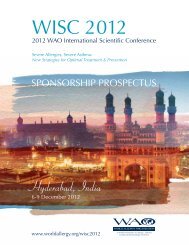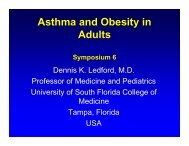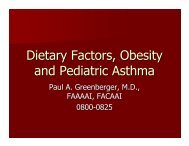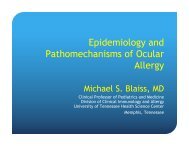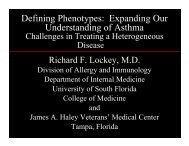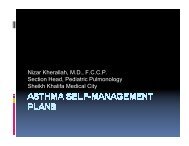Anti-IgE treatment in severe asthma - World Allergy Organization
Anti-IgE treatment in severe asthma - World Allergy Organization
Anti-IgE treatment in severe asthma - World Allergy Organization
You also want an ePaper? Increase the reach of your titles
YUMPU automatically turns print PDFs into web optimized ePapers that Google loves.
<strong>Anti</strong>-<strong>IgE</strong> Treatment In Severe Asthma<br />
Thomas B. Casale, MD<br />
Professor of Medic<strong>in</strong>e<br />
Chief, <strong>Allergy</strong>/Immunology<br />
Creighton University<br />
Omaha, NE
Relevant Disclosures<br />
•F<strong>in</strong>ancial Relationship/Consult<strong>in</strong>g Fees:<br />
Value< $10,000: MedImmune,<br />
• Research: All grants to Creighton University:<br />
Amgen, Novartis, Genentech, NIH, State Of Nebraska<br />
• Legal Consult/Expert Witness: None<br />
• <strong>Organization</strong>al: EVP of AAAAI and BOD WAO<br />
• Gifts: None<br />
• Other: N/A
Objectives<br />
To expla<strong>in</strong> the rationale beh<strong>in</strong>d <strong>IgE</strong><br />
blockade<br />
To consider which patients benefit<br />
To address how to assess response to<br />
<strong>treatment</strong>
The First Question<br />
• What is <strong>severe</strong> <strong>asthma</strong>?<br />
• Answer:<br />
–Depends upon who is ask<strong>in</strong>g and why
WHO Def<strong>in</strong>ition Of Severe Asthma<br />
• Def<strong>in</strong>ed by the level of current cl<strong>in</strong>ical control and<br />
risks which can result <strong>in</strong> frequent <strong>severe</strong><br />
exacerbations and/or adverse reactions to<br />
medications and/or chronic morbidity.<br />
• 3 groups, each carry<strong>in</strong>g different public health<br />
messages and challenges.<br />
– Untreated <strong>severe</strong> <strong>asthma</strong><br />
– Difficult to treat <strong>asthma</strong><br />
– Treatment resistant <strong>severe</strong> <strong>asthma</strong><br />
• Controlled on high dose medication<br />
• Not controlled on high dose medication<br />
Bousquet et al, JACI 2010
2009 ATS/ERS Task Force On<br />
Severe Asthma Def<strong>in</strong>ition<br />
• Asthma which requires <strong>treatment</strong> with high<br />
dose ICS (fluticasone > 1000 mcg/d or<br />
equivalent) plus a 2 nd controller (and/or<br />
systemic CS) to prevent a patient from<br />
becom<strong>in</strong>g “uncontrolled” or which, despite<br />
high dose therapy, rema<strong>in</strong>s “uncontrolled“.
Uncontrolled Asthma<br />
– Any one of the follow<strong>in</strong>g:<br />
• Poor symptom control: ACQ consistently >1.5<br />
(or “not well controlled” by NAEPP guidel<strong>in</strong>es)<br />
• Frequent exacerbations: 2 or more bursts of<br />
systemic CSs (>3 days each) <strong>in</strong> previous year<br />
• Severe exacerbations: at least 1<br />
hospitalization, ICU stay or mechanical<br />
ventilation <strong>in</strong> previous yr<br />
• Persistent airflow limitation: pre-short and long<br />
act<strong>in</strong>g bronchodilator FEV1< 80% predicted (<strong>in</strong><br />
the face of reduced FEV1/FVC)<br />
2009 ATS/ERS Task Force On Severe Asthma Def<strong>in</strong>ition
Second Question<br />
What Is the Role of <strong>IgE</strong> <strong>in</strong> Severe<br />
Asthma?
<strong>IgE</strong>- Mediated Allergic Reactions<br />
Bacteria<br />
Epithelium<br />
Allergens<br />
Secretion and<br />
Epithelial Permeability<br />
Immune-cell<br />
Recruitment<br />
and<br />
activation<br />
Blood flow<br />
coagulation<br />
and vascular<br />
permeability<br />
Neutrophil<br />
TNF<br />
Histam<strong>in</strong>e,<br />
LTC 4<br />
,<br />
Chymase, and<br />
hepar<strong>in</strong><br />
Blood vessel<br />
endothelium<br />
Adapted from Bischoff, Nature Immunol, ‘07<br />
Histam<strong>in</strong>e,<br />
LTC 4<br />
and<br />
PGD 2<br />
<strong>IgE</strong><br />
Mast Cell<br />
ILs-3,4, 5,6,8,9,11,13<br />
TNF-α, MIP1, MCP<br />
Eos<strong>in</strong>ophil B-cell T-reg Cell<br />
Immune cell<br />
activation and recruitment<br />
TGFβ and FGF<br />
Histam<strong>in</strong>e, PGD2,<br />
and proteases<br />
Nerve cell<br />
Wound heal<strong>in</strong>g<br />
and fibrosis<br />
Fibroblasts<br />
Smooth<br />
Muscle<br />
Cell<br />
Neuroimmune <strong>in</strong>teractions,<br />
Peristalsis bronchoconstriction<br />
and pa<strong>in</strong>
Prevalence of Asthma Related to Serum<br />
<strong>IgE</strong> Level Standardized for Age and Gender<br />
Prevalence of Asthma (%)<br />
40<br />
30<br />
20<br />
10<br />
0<br />
Age 6 to
Longitud<strong>in</strong>al Association Between <strong>IgE</strong> & Lung<br />
Function <strong>in</strong> Adult Asthmatic Non-Smokers<br />
85<br />
Log <strong>IgE</strong> = 0.8<br />
Log <strong>IgE</strong> = 1.75<br />
FEV1/FVC (%)<br />
80<br />
75<br />
70<br />
65<br />
35 55<br />
75<br />
Age (yrs)<br />
Sherrill DL, et al. Am J Respir Crit Care Med 1995;152:98-102.
The Relationship between <strong>IgE</strong> and<br />
FcεRI Expression<br />
Fractional <strong>in</strong>crease over Day 21<br />
3.0<br />
2.5<br />
<strong>IgE</strong> (500 ng/mL)<br />
2.0<br />
1.5<br />
Count<br />
1.0<br />
0.5 Log fluorescence<br />
<strong>IgE</strong> absence<br />
0<br />
0 1 2 3 4 5 6 7<br />
Incubation time (days)<br />
MacGlashan D, et al. Blood 1998;91:1633-43.
FcεRI Expression Upregulated <strong>in</strong> Asthma<br />
FcεRIα mRNA+ cells (x 10 6 cells)<br />
170<br />
160<br />
30<br />
20<br />
10<br />
0<br />
Asthma<br />
Patients<br />
p=0.02<br />
Controls<br />
FcεRI+ (22E7) cells/mm 2<br />
180<br />
160<br />
140<br />
120<br />
100<br />
80<br />
60<br />
40<br />
20<br />
0<br />
p=0.001<br />
p=0.006<br />
p=0.0006<br />
Sal<strong>in</strong>e Allergen<br />
Sal<strong>in</strong>e Allergen<br />
Atopic<br />
<strong>asthma</strong>tics<br />
Non-atopic<br />
<strong>asthma</strong>tics<br />
Atopic<br />
controls<br />
Non-atopic<br />
controls<br />
Rajakulas<strong>in</strong>gam K, et al. Am J Respir Crit Care Med 1998;158:233-40.<br />
Humbert M, et al. Am J Respir Crit Care Med 1996;153:1931-7.
Expression of High-Aff<strong>in</strong>ity <strong>IgE</strong> Receptor<br />
Increased <strong>in</strong> Fatal Asthma<br />
FcεRI receptor expression <strong>in</strong><br />
lam<strong>in</strong>a propria (+ cells/mm 2 )<br />
1200<br />
1000<br />
800<br />
600<br />
400<br />
200<br />
0<br />
*P
Mechanisms Of Action of Omalizumab<br />
eNO<br />
airway eos<strong>in</strong>ophils,<br />
mast cells,<br />
basophils, T + B<br />
lymphocytes<br />
<strong>IgE</strong>+, FcεRI+,<br />
IL-4+cells <strong>in</strong><br />
bronchial<br />
epithelium<br />
response<br />
to allergen<br />
sk<strong>in</strong> test<br />
Lung Ag Challenge<br />
free <strong>IgE</strong>, <strong>IgE</strong> bound to<br />
FceRI, and FceRI expression<br />
on mast cells, basophils,<br />
dendritic cells,monocytes
Omalizumab Down-Regulates FcεRI<br />
Expression on Dendritic Cells <strong>in</strong> SAR<br />
pDC1<br />
FcεRIα (MFI)<br />
>600<br />
450<br />
300<br />
150<br />
0<br />
Omalizumab<br />
*<br />
**<br />
***<br />
***<br />
0 7 14 28 42<br />
FcεRIα (MFI)<br />
>600<br />
450<br />
300<br />
150<br />
0<br />
Placebo<br />
0 7 14 28 42<br />
>100<br />
75<br />
pDC2<br />
50<br />
25<br />
0<br />
* **<br />
0 7 14 28<br />
Study day<br />
*<br />
*<br />
42<br />
>100<br />
75<br />
50<br />
25<br />
0<br />
0 7 14 28<br />
Study day<br />
42<br />
Pruss<strong>in</strong> C, et al. J <strong>Allergy</strong> Cl<strong>in</strong> Immunol 2003;112:1147-54.<br />
*p
Effects Of Omalizumab On Airway Inflammation<br />
In Mild Atopic Asthmatics<br />
5-center, double bl<strong>in</strong>d , placebo-controlled, controlled, parallel-<br />
group, 16-week study (n=44) :<br />
•Reduction <strong>in</strong> submucosal eos: 8.0 to 1.5<br />
•10<br />
10-fold reduction <strong>in</strong> <strong>IgE</strong>+cells<br />
- Decreases <strong>in</strong> FCεRI cells<br />
•Decreases <strong>in</strong> B cells, and CD3+, CD4+, and<br />
CD8+ cells ……<br />
•implies that <strong>IgE</strong> plays an important role <strong>in</strong><br />
airway <strong>in</strong>flammation <strong>in</strong> <strong>asthma</strong><br />
R Djukanovic, et al, AJRCCM,170:583,2004
Omalizumab Decreases FcεRI <strong>in</strong><br />
Bronchial Biopsies<br />
Pre-Omalizumab<br />
Post-Omalizumab<br />
Djukanović R, et al. Am J Respir Crit Care Med 2004;170-583-93.
Omalizumab Significantly Reduces<br />
Submucosal Eos<strong>in</strong>ophils<br />
80<br />
p=0.033<br />
p=0.81<br />
80<br />
Eos<strong>in</strong>ophils (cells/mm 2 )<br />
60<br />
40<br />
20<br />
0<br />
p
Cl<strong>in</strong>ical Effects Of Omalizumab:<br />
Pooled data from 7 trials<br />
In patients on ICS alone, or <strong>in</strong> comb<strong>in</strong>ation with other<br />
agents, addition of omalizumab:<br />
Reduced number of exacerbations<br />
Reduced symptom scores<br />
Reduced need for <strong>in</strong>haled corticosteroids<br />
Reduced use of rescue medication<br />
Improved <strong>asthma</strong>-related quality of life<br />
Consider us<strong>in</strong>g <strong>in</strong> patients with poor control despite<br />
optimal care<br />
1<br />
Busse W et al. J <strong>Allergy</strong> CL<strong>in</strong> Immunol 2001;108:184-90.<br />
2<br />
Soler M et al. Eur Respir J 2001;18:254-61.<br />
3<br />
Humbert M, et al. <strong>Allergy</strong> 2005;60:309-16.
Effects Of Omalizumab On Exacerbations<br />
G Rodrigo et al, Chest, 2010
Effects Of Omalizumab on Secondary Endpo<strong>in</strong>ts<br />
G Rodrigo et al, Chest, 2010
Omalizumab effect was <strong>in</strong>dependent of:<br />
<br />
<br />
<br />
Duration of <strong>treatment</strong><br />
Age<br />
Severity of <strong>asthma</strong>
Omalizumab In<br />
Children 6 - 11<br />
Avg FP dose 515 mcg<br />
2/3 on LABA<br />
1/3 on LTRA<br />
Lanier et al. JACI.2009;124:1210-6
Effects Of Omalizumab In Elderly<br />
All on high dose ICS & 50% on OCS<br />
S Korn et al, Ann <strong>Allergy</strong> Asthma Immunol. 2010;105:313–319.
Steps of Therapy: Age ≥12 Years
Steps of Therapy: Age ≥12 Years<br />
Interm ittent<br />
Asthm a<br />
Persistent Asthm a: Daily M edication<br />
C onsult w ith asthm a specialist if step 4 care or higher is required.<br />
Consider consultation at step 3.<br />
Step 1<br />
Preferred:<br />
SABA PRN<br />
Step 2<br />
Preferred:<br />
Low-dose ICS<br />
Alternative:<br />
Crom olyn, LTRA,<br />
Nedocrom il, or<br />
Theophyll<strong>in</strong>e<br />
Step 3<br />
Preferred:<br />
Low-dose<br />
ICS + LABA<br />
OR<br />
Medium -dose ICS<br />
Alternative:<br />
Low-dose ICS +<br />
either LTRA,<br />
Theophyll<strong>in</strong>e, or<br />
Zileuton<br />
Step 4<br />
Preferred:<br />
M edium -dose ICS<br />
+ LABA<br />
Alternative:<br />
M edium -dose ICS<br />
+ either LTRA,<br />
Theophyll<strong>in</strong>e, or<br />
Zileuton<br />
Step 5<br />
Preferred:<br />
High-dose<br />
ICS + LABA<br />
AND<br />
Consider<br />
Om alizumab for<br />
patients who have<br />
allergies<br />
Step 6<br />
Preferred:<br />
High-dose<br />
ICS + LABA + oral<br />
corticosteroid<br />
AND<br />
Consider<br />
Om alizumab for<br />
patients who have<br />
allergies<br />
Step up if<br />
needed<br />
(first, check<br />
adherence,<br />
environmental<br />
control, and<br />
com orbid<br />
conditions)<br />
Assess<br />
control<br />
Step down if<br />
possible<br />
Each step:<br />
Steps 2−4:<br />
Patient education, environm ental control, and m anagem ent of com orbidities.<br />
Consider subcutaneous allergen imm unotherapy for patients who have allergic <strong>asthma</strong> (see notes).<br />
(and asthm a is<br />
well controlled<br />
at least<br />
3 m onths)<br />
Quick-Relief Medication for All Patients<br />
• SABA as needed for symptom s. Intensity of treatm ent depends on severity of sym ptom s: up to 3 treatm ents at 20-m<strong>in</strong>ute <strong>in</strong>tervals<br />
as needed. Short course of oral systemic corticosteroids m ay be needed.<br />
• Use of SABA >2 days a week for symptom relief (not prevention of EIB) generally <strong>in</strong>dicates <strong>in</strong>adequate control and the need to step<br />
up <strong>treatment</strong>.
Dos<strong>in</strong>g Table:<br />
0.016 mg/kg/IU/mL every 4 weeks<br />
Monthly Dos<strong>in</strong>g<br />
Body Weight (kg)<br />
Biweekly Dos<strong>in</strong>g<br />
> 100-200<br />
450<br />
> 200-300<br />
450 450 450 600<br />
> 300-400<br />
450 450 600 600<br />
> 400-500<br />
600 600 750 750<br />
> 500-600<br />
600 750<br />
> 600-700<br />
750
Omalizumab Onset Of Action In Asthma<br />
Asthma trials suggest that 8 to 16 weeks of<br />
<strong>treatment</strong> might be a reasonable therapeutic trial:<br />
While the onset of response was<br />
measurable at 4 weeks, the proportion of<br />
responders cont<strong>in</strong>ued to <strong>in</strong>crease<br />
throughout the 16 week period:<br />
4 wks: 61%<br />
8 wks: 78%<br />
12 wks: 87%
Factors Predictive of Response to<br />
Omalizumab<br />
*Relative Rate<br />
(Confidence Interval)<br />
1.87*<br />
(0.88 – 3.99)°<br />
N = 120<br />
BDP dose ≥ 800 µg/day<br />
FEV 1 ≤65%<br />
predicted<br />
1.15<br />
(0.54 – 2.44)<br />
N = 114<br />
2.25<br />
(1.02 – 4.97) 4.20<br />
N = 103 (1.69 – 10.45)<br />
N = 85<br />
3.38<br />
(1.32 – 8.66)<br />
N = 77<br />
Bousquet J, et al. Chest. 2004;125:1378-1386.<br />
3.54<br />
(1.69 – 7.43)<br />
N = 124<br />
1.60<br />
(0.75 – 3.42)<br />
N = 119<br />
History of<br />
emergency<br />
<strong>asthma</strong><br />
<strong>treatment</strong><br />
<strong>in</strong> past year
Adequate <strong>IgE</strong> Suppression is Needed<br />
to Demonstrate Cl<strong>in</strong>ical Response<br />
Serum free <strong>IgE</strong><br />
(ng/mL)<br />
400<br />
300<br />
50mg<br />
150mg<br />
300mg<br />
Average nasal severity<br />
scores<br />
1.1<br />
1.0<br />
Placebo<br />
**p
Factors Predictive Of Cl<strong>in</strong>ical Response<br />
• Reasons for omalizumab be<strong>in</strong>g <strong>in</strong>effective for some<br />
(~40%) patients are unknown.<br />
• Improvements correlate with <strong>IgE</strong> reductions, BUT<br />
free <strong>IgE</strong> levels <strong>in</strong> nonresponders are similar to those<br />
found <strong>in</strong> responders 1<br />
• Possible reasons: 2<br />
(1) Relationship between free <strong>IgE</strong> levels and FcεR1<br />
expression<br />
(2) Ratio of specific <strong>IgE</strong> to total <strong>IgE</strong><br />
(3) Intr<strong>in</strong>sic cellular sensitivity.<br />
1. Slav<strong>in</strong>, et al. JACI . 2009;123:107<br />
2. MacGlashan. JACI 2009;23: 114
Do the Effects Of Omalizumab Cont<strong>in</strong>ue<br />
After Treatment Is Stopped?<br />
• Conflict<strong>in</strong>g data, but may depend upon<br />
duration of <strong>treatment</strong><br />
• 2 different studies with 2 different answers:<br />
1. INvestigation of Omalizumab <strong>in</strong> seVere<br />
Asthma TrEatment (INNOVATE) study<br />
2. Nopp et al, 2010 <strong>Allergy</strong>
28-week Omalizumab Treatment And<br />
16-week Follow-up<br />
N=476,<br />
Dark=Omal, Light=Pl<br />
Slav<strong>in</strong>, et al. JACI . 2009;123:107
Effects Of Omalizumab On Asthma Control 3<br />
Years After 6 Years Treatment<br />
A Nopp et al, <strong>Allergy</strong> 2010
Omalizumab and Asthma Summary<br />
• Omalizumab is effective <strong>in</strong> children and adults<br />
<strong>in</strong> reduc<strong>in</strong>g exacerbations and steroid<br />
requirements<br />
– Also positive effects on SABA use, QOL, Sxs<br />
and PFTs (m<strong>in</strong>or)<br />
• Omalizumab has anti-<strong>in</strong>flammatory effects<br />
• If not effective by 4-6 months, probably will not<br />
be effective<br />
– Predictors of who will respond are unclear<br />
• Whether omalizumab can be stopped with<br />
susta<strong>in</strong>ed cl<strong>in</strong>ical efficacy is unclear<br />
– May depend on duration of <strong>treatment</strong>
Other Potential Cl<strong>in</strong>ical Uses of<br />
Omalizumab In Asthma<br />
• SAR and PAR +/- Asthma<br />
• Non-allergic Asthma<br />
•ABPA<br />
• Adjuvant to Traditional Immunotherapy:<br />
•Increased Efficacy As Add On <strong>in</strong> SAR<br />
•Improved Safety As Pre<strong>treatment</strong>:<br />
• 80% Decr In RIT Assoc Anaphylaxis <strong>in</strong> SAR<br />
• 50% Decr In Cluster Assoc AEs <strong>in</strong> Asthma
Omalizumab and Immunotherapy:<br />
Study Design<br />
150 Patients per arm, Randomized 1:1<br />
Omalizumab<br />
Cluster IT<br />
Ma<strong>in</strong>tenance IT<br />
Screen<strong>in</strong>g<br />
Placebo<br />
Cluster IT<br />
Ma<strong>in</strong>tenance IT<br />
3 wk overlap<br />
Period 1 Period 2 Period 3 Period 4<br />
Visit 0 Visit 1 Visit 5 Visit 11 Visit 14 Visit 19<br />
-2wks 0 13wks 16 wks 17 wks 24 wks<br />
Persistent perennial allergic <strong>asthma</strong>tics requir<strong>in</strong>g ICS & FEV1 > 75%
Proportion of Patients Who Experienced A<br />
Systemic Allergic Reaction: Primary Endpo<strong>in</strong>t<br />
30.0%<br />
25.0%<br />
20.0%<br />
26.2%<br />
P= 0.017<br />
15.0%<br />
13.5%<br />
10.0%<br />
5.0%<br />
N = 32<br />
N = 17<br />
0.0%<br />
N=122 N=126<br />
Placebo<br />
Omalizumab<br />
M Massanari<br />
et al, JACI, 2010
Severity of First Systemic<br />
Allergic Reaction<br />
Number of Patients<br />
30<br />
25<br />
20<br />
15<br />
10<br />
5<br />
0<br />
6<br />
7<br />
0<br />
2<br />
24<br />
6<br />
2<br />
2<br />
Grade 1 (Sk<strong>in</strong>) Grade 2 (GI) Grade 3<br />
(Resp)<br />
Grade 4 (CV)<br />
M Massanari<br />
et al, JACI, 2010<br />
Placebo (n=32)<br />
Omalizumab (n=17)
Omalizumab and IT Conclusions<br />
• Pre<strong>treatment</strong> with omalizumab:<br />
• Added Efficacy to SCIT<br />
•Added Safety to SCIT<br />
•Allowed more patients to reach ma<strong>in</strong>tenance<br />
• 87 vs. 72% (p
Omalizumab Safety Issues<br />
Anaphylaxis<br />
Cancer<br />
Cardiovascular<br />
Other?
Major Unanswered Question<br />
If <strong>Anti</strong>-<strong>IgE</strong> Prevents Anaphylaxis By<br />
Decreas<strong>in</strong>g Circulat<strong>in</strong>g and Bound <strong>IgE</strong>…..<br />
And <strong>IgE</strong> is essential for development of<br />
anaphylaxis……..<br />
How does it cause anaphylaxis?????<br />
- Incidence ~0.1 to 0.2%
Conclusions<br />
S<strong>in</strong>ce <strong>IgE</strong> plays an important role <strong>in</strong> a number of<br />
diseases, strategies aimed at block<strong>in</strong>g the effects of<br />
it will likely prove important…..<br />
• Not just for <strong>asthma</strong> and rh<strong>in</strong>itis<br />
Omalizumab has many potential therapeutic<br />
applications<br />
• On go<strong>in</strong>g safety issues need to be monitored<br />
Small, easy to make and deliver antagonists should<br />
be pursued, especially those that….<br />
• Induce tolerance



